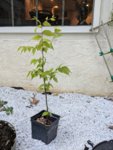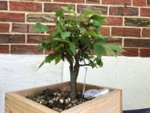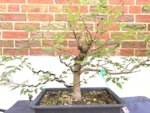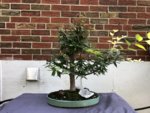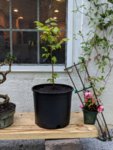You are using an out of date browser. It may not display this or other websites correctly.
You should upgrade or use an alternative browser.
You should upgrade or use an alternative browser.
Zelcova Seedlings
- Thread starter AlissaMoo
- Start date
sorce
Nonsense Rascal
If you got a few...
Do a little something different to each.
Learn what they can take.
Welcome to Cray Cray!
Sorry for the delay!
Sorce
Do a little something different to each.
Learn what they can take.
Welcome to Cray Cray!
Sorry for the delay!
Sorce
bwaynef
Masterpiece
I just up-potted zelkova seedlings from 60-cell rootmaker pots to 32-cell rootmaker pots. On ones with cells full of roots, I chopped them back to the top section (look at rootmaker rootballs to see what I'm talking about), roughly organized the roots, and replanted them. At this point, I'm trying to get good roots. Everything else will follow. (An alternative approach, and one that I've seen by someone here, is to let them grow freely and airlayer for good roots. He's got the results, so I might be doing it wrong.)
Gaitano
Shohin
I received ten seedlings a few years back. I stuck them in the ground over a tile the following spring and they took off. Cuttings root very easily, they air layer easily. soon you will have plenty to play with.
Attachments
AlainK
Imperial Masterpiece
Hi Alissa Moo,
Judging by the dry leaf of red oak that I can see in the background, you must be from a temperate place in the US.
Zelkova (with a "K") is a tree that can forgive many mistakes.
It can grow quite fast when planted in the ground, but stays very small when potted, so I would put it in a shallower container so the root will spread more horizontally, and feed it a lot. Also, it backbuds profusely when pruned.
For instance, I bought a Zelkova sinica last year, almost the same as Zelkova serrata, except for the bark. It was in a deep square plastic pot, and I almost lost it last summer. I repotted it with a much better soil, and in a wider and shallower plastic pot. It's throwhn new shoots the length of last year's seedling:

In the top-right of the photo, you can see the base of a crab-apple from seed. Same procedure: I use "spiraling wires to make sure the roots are not disturbed by the wind. Not very elegant, but efficient, and they don't harm the roots of trees that are still in their first stage.
Judging by the dry leaf of red oak that I can see in the background, you must be from a temperate place in the US.
Zelkova (with a "K") is a tree that can forgive many mistakes.
It can grow quite fast when planted in the ground, but stays very small when potted, so I would put it in a shallower container so the root will spread more horizontally, and feed it a lot. Also, it backbuds profusely when pruned.
For instance, I bought a Zelkova sinica last year, almost the same as Zelkova serrata, except for the bark. It was in a deep square plastic pot, and I almost lost it last summer. I repotted it with a much better soil, and in a wider and shallower plastic pot. It's throwhn new shoots the length of last year's seedling:

In the top-right of the photo, you can see the base of a crab-apple from seed. Same procedure: I use "spiraling wires to make sure the roots are not disturbed by the wind. Not very elegant, but efficient, and they don't harm the roots of trees that are still in their first stage.
Last edited:
TommyHallahan
Yamadori
What do you mean when you say "spiraling wires"?Hi Alissa Moo,
Judging by the dry leaf of red oak that I can see in the background, you must be from a temperate place in the US.
Zelkova (with a "K") is a tree that can forgive many mistakes.
It can grow quite fast when planted in the ground, but stays very small when potted, so I would put it in a shallower container so the root will spread more horizontally, and feed it a lot. Also, it backbuds profusely when pruned.
For instance, I bought a Zelkova sinica last year, almost the same as Zelkova serrata, except for the bark. It was in a deep square plastic pot, and I almost lost it last summer. I repotted it with a much better soil, and in a wider and shallower plastic pot. It's throwhn new shoots the length of last year's seedling:
View attachment 196482
In the top-right of the photo, you can see the base of a crab-apple from seed. Same procedure: I use "spiraling wires to make sure the roots are not disturbed by the wind. Not very elegant, but efficient, and they don't harm the roots of trees that are still in their first stage.
AlainK
Imperial Masterpiece
What do you mean when you say "spiraling wires"?
When you use wire so the tree doesn't move in a pot, you usually use two opposed holes in the base of the pot. It can also flatten some of the roots that grow too much upwards.
But that's when your tree is beginning to establish itself, here it's just repotting to make sure that the tree can survive, so the way the roots spread is the least of the problem. If the tree survives, if it's healthy, vigorous, for most deciduous trees the solution will be layering id the "nebary" is really crappy.
"Spiraling wires" is my way, as a non-native speaker of English, to try and make others understand what I do: instead of putting pressure on the roots, I take the option of keeping the tree straight. See what I mean?
Here is another example of what I mean, a small Larix x eurolepis. Picture taken 18/06/06 :

If I had chosen to tighten the roots with horizontal wiring, I might have damaged the very few roots.
The "spiraling wires" maintains the tree without any risk of damaging the roots. The pot is only about 12 cm wide, 1.5 cm deep (5 inches, half an inch + , roughly).
Tu vois ce que je veux dire ?...
Ok, so I took all advice and did something a little different with each tree...one I plant in
the ground, another in a much larger growing pot with soil, another in a bonsai training pot and trimmed the roots, the fourth my dog destroyed, one left...any suggestions?
the ground, another in a much larger growing pot with soil, another in a bonsai training pot and trimmed the roots, the fourth my dog destroyed, one left...any suggestions?
Attachments
hemmy
Omono
I believe you’ll have more success if decide your end goal for the “style”, height and necessary caliper. For anything not upright broom, you should wire some low movement now, even if you are going into the ground and will have eventual low chops or air layers. Depending on the desired trunk diameter, you may be able to achieve it in a container with sacrifice branches/trunks or have to to the ground if you need several inches.

